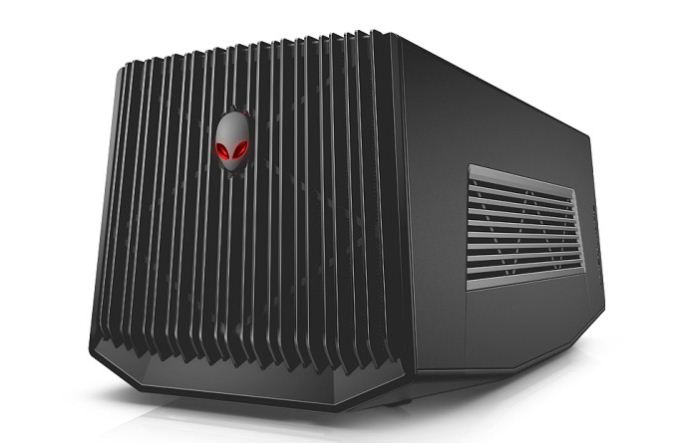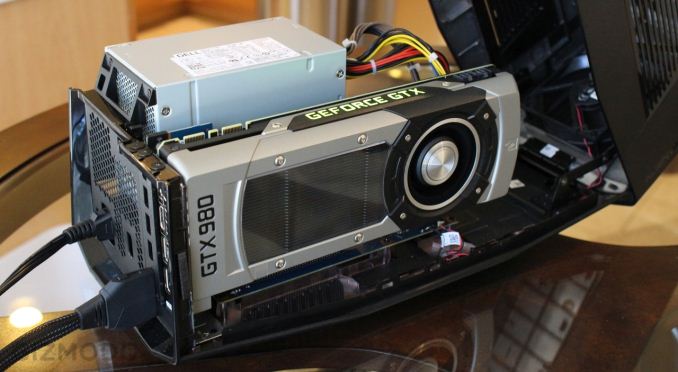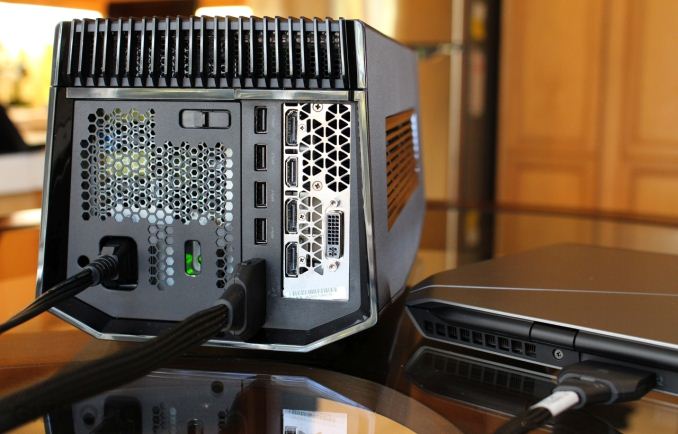Alienware's Graphics Amplifier Announced - An External Video Card Chassis Shipping Soon
by Ryan Smith on October 28, 2014 9:00 AM EST
The idea of an external PCI-Express chassis for video cards is practically as old as PCI-Express itself. However over the years the idea has failed to reach the consumer market as a complete product, even with the introduction of standardized external PCIe interfaces such as Thunderbolt. Various prototypes have been shown, but in practice the only way to acquire such a rig has been to build it yourself, combining an ExpressCard slot and its pokey PCIe 2.0 x1 link with an external PCIe chassis.
Thankfully it looks like the PC industry is finally going to turn the corner on the concept thanks to Alienware. Today Alienware is introducing their own PCIe video card chassis, the Alienware Graphics Amplifier.
Alienware’s amplifier is a fairly typical take on the concept – there are only so many ways to build an external PCIe chassis – however Alienware has been able to put together something that is clearly tuned for video cards. The chassis itself houses a PSU and a single x16 PCIe slot for a video card, along with a quartet of USB 3.0 ports for any other I/O needs. Notably, Alienware has designed the amplifier to be able to handle double-wide video cards up to 375W, which is quite a bit more power than professional grade external PCIe chassis, and this means it can conceivably run just about any self-contained video card on the market. That said, like many small form factor computers the amplifier is also clearly designed for video cards with fully exhausting blowers, so it’s going to be best paired with reference model video cards since blowers are nearly non-existent in custom cards these days.

Alienware's Graphics Amplifier Opened (Image Courtesy Gizmodo)
More interesting perhaps is the PCIe interface, which up until now has always been the sticking point in getting a video card chassis to market. The good news is that Alienware has more or less solved the problem, but the bad news is that the interface is a proprietary Alienware/Dell design that is only available on their laptops. Alienware notes that the interface is actually a PCIe + USB interface – apparently carrying USB over from the host rather than using PCIe to power a separate controller – and in the meantime we’re still working to determine just how many PCIe lanes the interface is carrying. Even if it’s not a full 8 lanes (the Haswell U series CPUs don’t support 16 lanes), given the severe bandwidth limitations of ExpressCard and Thunderbolt, even a 4 lane setup would represent a significant improvement in bandwidth. Like Thunderbolt however this interface does appear to use active cabling (it would be very difficult to carry that much bandwidth externally without it), in which case the cable is going to be an expensive part of the entire setup.
On the host side, the amplifier is being launched alongside the Alienware 13, which will be the first of what will presumably be a series of Alienware laptops to support the amplifier’s interface. Rather than hanging off of spare PCIe lanes, we suspect some kind of MUX is in play here, as Alienware has noted that the 13’s internal dGPU (a GeForce 860M) has to be shut off to use the amplifier interface. Most likely Alienware is rerouting the GPU’s lanes to the interface when it’s in use. Activating or deactivating the interface does require a reboot, which although not especially convenient bypasses some very messy issues that could occur when hot-plugging an active GPU, and we suspect would otherwise be a show-stopper.

Alienware's Graphics Amplifier Up Close (Image Courtesy Gizmodo)
Meanwhile it’s interesting to note that in their development process Alienware has been able to solve some of the technical issues around an external video card in the process to better integrate it with the host. The video card in an amplifier can be used to drive both external and internal displays, meaning that it’s possible to use the amplifier to drive the 13’s built-in display and still reap the benefits, even without an external monitor. The overall non-portability of the 7lb+ amplifier and the USB ports strongly drives the amplifier towards being used as a docking station with an external monitor, but if you want to use it to drive the internal display that is going to be a viable option.
Moving on, Alienware is taking a vendor agnostic approach with the amplifier and will be supporting NVIDIA as well as AMD GPUs. There are still some additional technical details we’re chasing down on how this will work with the internal display capabilities, but ultimately it means the amplifier can be used with a wide range of cards from both vendors. That said, since the amplifier is going to be best paired with a blower type video card, NVIDIA’s cards are going to be the more natural fit at this time. Alienware has been showing the amplifier off with the GTX 980, and next to being the most powerful single-GPU video card on the market it also has a reference blower that is an excellent match for the amplifier’s cooling capabilities.
Finally and perhaps most importantly, Alienware has made it clear that the amplifier isn’t a prototype and won’t be vaporware, and that we’re looking at an external video card chassis that is actually going to ship. Alienware will begin taking orders for the amplifier today alongside the Alienware 13 laptop, with the hardware shipping in November. Even the price is decent (especially compared to DIY attempts), with the amplifier set to cost $299. This is on top of the price of the Alienware 13 laptop and the video card to fill the amplifier with, so the total cost of a setup is still going to be significant, but despite being the first shipping consumer solution it’s not priced through the roof.
Source: Alienware










80 Comments
View All Comments
Wolfpup - Tuesday, October 28, 2014 - link
SWEEEEEET!I'm not sure what "blower" cards are? Just that it blows the hot air out the back? Don't all cards do that?
My other concern is...does this just use regular Nvidia or AMD drivers? Or require something special? Because if it needs some proprietary drivers, that kills it. I'm guessing it just works with Nvidia's desktop drivers though...
Obviously it's disappointing you can't add it to any notebook...I'd buy this + a Geforce 980 for my 680m based Alienware M17x-R4, but at least going forward this is yet another reason I'd stick with Alienware (besides the fact I've found them very well built and designed.)
DanNeely - Tuesday, October 28, 2014 - link
Look at the GPU in the 2nd picture. It has a small fan at the front and a shroud mostly covering the heatsink over the rest of the card. That' s a blower cooler; it works by blowing hot air out the back. Most reference designs use them because they're marginally cheaper and will work in almost any case.The other major style of cooler is what's known as open air. They use 2 or 3 fans and don't have a shroud to direct the air out the back. Instead it's dispersed into the rest of the case. Because they use more and larger fans these designs are quieter; and in a well ventilated case generally somewhat cooler as well. However if you put one in a case that has little or no ventilation of its own; everything is going to end up baking.
http://www.tigerdirect.com/applications/searchtool...
zodiacfml - Tuesday, October 28, 2014 - link
lol. that is huge. that's already the size of a mini-itx, and probably in price too.jtd871 - Tuesday, October 28, 2014 - link
It's smaller than mITX - looks just big enough at the end for a standard ATX PSU and a triple-slot (including the USB? ports). It is reminiscent of Silverstone's T004/Asus XG2. For the $300(?) cardless price reported above you could get a FT-03 mini and a SFX PSU to put a mITX system in and have change left over.zodiacfml - Wednesday, October 29, 2014 - link
agreed. i just can't see any practical purpose......unless someone has more money than time on their hands.meacupla - Saturday, November 1, 2014 - link
I think there are two different ways to look at this.Portable gaming laptop w/ full desktop graphics and monitors at home
-or-
mITX gaming PC that requires separate monitor, keyboard and mouse to use
The former is better if you want to travel lightly, but the latter is better if you don't mind carrying the monitor or buying another one locally.
IMO, the latter would work better if laptops or tablets accepted external inputs, as those are the perfect size to pair with mITX PCs.
SirKnobsworth - Tuesday, October 28, 2014 - link
I'm curious if this box can power the laptop as well or if it still requires a power brick...Gunbuster - Tuesday, October 28, 2014 - link
Would be neat if they had designed it so you could dock the laptop to it for power and extra cooling.coburn_c - Tuesday, October 28, 2014 - link
Welcome back Michael Dell.Morawka - Tuesday, October 28, 2014 - link
where is the ipad air 2 review?